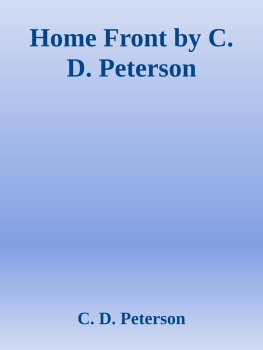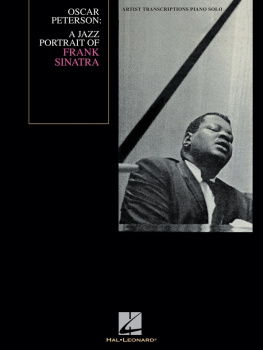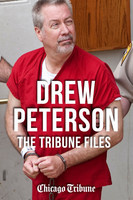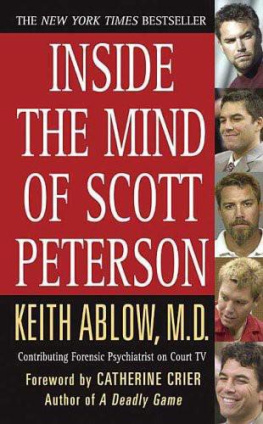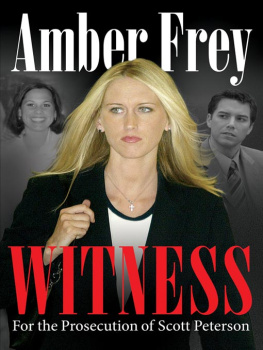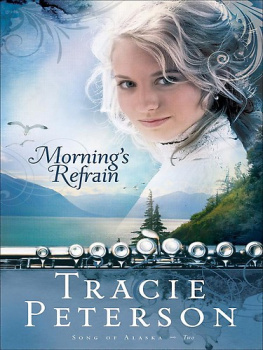All rights reserved, including the right to reproduce this book or portions thereof in any form whatsoever. For information address Atria Books, 1230 Avenue of the Americas, New York, NY 10020
ATRIA BOOKS is a trademark of Simon & Schuster, Inc.
Introduction
The Book That Had
to Be WrittenNow
NOVEMBER 12, 2004, 1:10 P.M .
REDWOOD CITY, CALIFORNIA
T he jury moved into the jury box. The packed courtroom waited.
Accused murderer Scott Peterson sat expressionless and still as the court clerk began to read the verdict form.
After 184 witnesses testifying over twenty-three weeks, the closing arguments had been made. Defense attorney Mark Geragos said in his closing arguments that prosecutors had not proven their case.
But if you hate him, then maybe what theyre asking you to do is just convict him. Dont bother with the five months of evidence, Geragos said. Dont bother with the fact that the evidence shows clearly that he didnt do this and had absolutely no motive to do this. Youre not supposed to just decide this case on whether or not you like Scott Peterson.
Prosecutor Rick Distaso insisted that Peterson was the only one who could have killed his wife. The best way to look at [the evidence] is like a jigsaw puzzle, he said. Each piece that Ive talked to you about today fits only in one direction, and that is that this man is guilty of murder.
Finally, the court clerks voice rang out. We the jury in the above-entitled cause, find the defendant, Scott Lee Peterson, guilty of the crime of the murder of Laci Denise Peterson.
Sharon Rocha, Laci Petersons mother, sobbed and fell forward in her seat into the arms of her son, Brent. Gasps came from Lacis friends, whod hurried to Redwood City in time to hear the verdict.
The trial that had begun June 1, 2004, amid promises of witnesses and evidence that never materialized, was over. Scott Peterson had been found guilty. The verdict was first degree for Laci, second degree for her unborn son, Conner.
This was more than another true-crime drama to me. It represented six months of my life, countless hours of investigation, and a sick sense of dread that justice would not prevail because the jury did not have the same information I did.
I never planned to write a book about the Scott Peterson murder trial. Although I left the defense before the case went to trial, I couldnt forget it. After the frustration and disappointment I encountered while working on Petersons defense team, I wanted to put the entire nightmare behind me. But I couldnt.
The questions would come when I least expected themsometimes driving down the freeway, sometimes moments before sleep, and always when I picked up a newspaper or watched one of the ubiquitous news broadcasts dissecting the case.
What had happened to the information Id uncovered about the van that was sitting across from Lacis house the morning of the twenty-fourth and was later seen speeding away from the area where she was last seen walking? The pregnant woman who was being terrorized in the neighborhood? The numerous other pregnant women whod disappeared in the area? The crime spree in Lacis neighborhood that started hours before she disappeared? The screaming coming from that park bathroom where Laci was seen walking the morning of December 24, 2002? Why was there no testimony from the witnesses Id interviewed whod seen Laci with her dog that day? What about the felons who were breaking into the house across the street the morning of December 24?
Why was Scott Peterson on death row?
Those questions continue to haunt me; they are the basis of this book.
Joining Geragos
Over the years that Mark Geragos and I had known each other, wed talked about working together. I met Mark when I was in college. We were both working for our fathers, well-known criminal defense lawyers who had offices together in the early 1980s. Mark was in law school clerking at the firm. I was an undergraduate student at the University of California, Los Angeles majoring in economics. I worked at the firm part-time doing the payroll and bookkeeping. My father enjoyed great success and managed to retire early from practicing law. Mark later passed the bar, and he and his father began practicing together. After graduating from college, I went to law school and then became a prosecutor.
While working as a Los Angeles County deputy district attorney in February 2001, I began a lengthy, complex investigation into public corruption within the City of Los Angeles. I spent two years on this investigation, using surreptitious electronic devices, interviewing witnesses, and reading through more than one million different documents. I examined every small detail, looking for the smoking gun, that small piece of information that would prove a crime was being committed. I learned from this experience that a good investigator lives and breathes the facts of his case. That is what I did. Although I didnt know it at the time, it was the perfect preparation for the work I would have to do in the Peterson case.
Very soon after starting this public corruption investigation, I became focused on one particular area of possible corruption in the City of Los Angeles that I believed should be vigorously pursued. Relationships existed between city officials and contributors in the form of campaign donations in a pay to play environment I felt should not be tolerated.
I believed we were closing in on a prosecutable case. However, it was just at this point that Steve Cooley, the Los Angeles district attorney, and a career bureaucrat, decided to end the investigation. I had no idea why.
The Los Angeles Times ran a feature article regarding the investigations termination in which one of its columnists described the situation as like a chapter from L.A. Confidential a deepening web of political intrigue complete with bribery allegations, bugging devices, a bag man, and a dogged prosecutor turned away by his bosses.
In January 2003, after thirteen years as a career prosecutor involved in all aspects of criminal litigation with the Long Beach City Prosecutors Office and the Los Angeles County District Attorneys Office, Id finally had enough.
As I was coming back from hearing Steve Cooleys decision to call off the investigation, I saw Mark Geragos in the hallway at the Criminal Courts Building in downtown Los Angeles. He again asked me when I was going to come work with him and his father.
I was fed up with what I perceived as politics and civil service inertia in the district attorneys office. The offer to go work with the Geragos firm seemed like the perfect solution. It was a possibility that Id considered for a long time, and now I took him up on it. I had no idea what awaited me as a defense attorney.
Two months after leaving the district attorneys office, I was working full time in Modesto, California, investigating the murder of Laci Peterson. For approximately six months, I worked exclusively on the Peterson case, interviewed scores of witnesses, reviewed the physical facts, and visited the relevant scenes. I thoroughly examined more than thirty thousand pages of police investigation, much of which was unlike any investigative reports I had seen as a Los Angeles prosecutor.
After the guilty verdict in the Peterson case, I was contacted by a member of the press. This person asked me how I felt about the jurys decision and said, Let me interview you. I was tempted to accept. Although it would have been cathartic just to talk the story out of my system, I knew that it would ultimately do little good.


